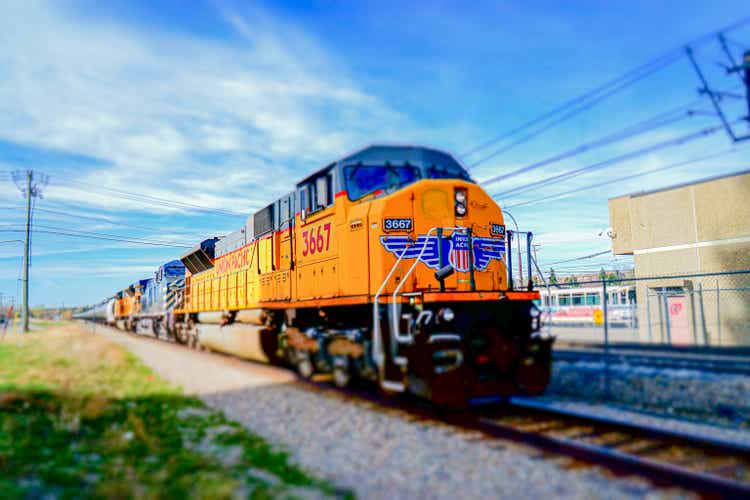
Osarieme Eweka
Union Pacific (NYSE:UNP) recently reported better-than-expected results with both revenues and EPS beating consensus estimates. Revenue of ~$6.57 bn beat consensus estimates by ~$160 mn, adjusted EPS of $3.19 was better than consensus estimates by 13 cents. The adjusted number excluded a ~$114 mn charge for prior period estimates related to the new labor agreements. Revenue for the quarter benefited from a ~14.5% Y/Y increase in yields while volume was up ~3.2% Y/Y. The adjusted operating ratio deteriorated 190 bps Y/Y to ~58.2%, but was a sequential improvement versus Q2’s operating ratio of ~60.2%.
The real bummer was the company’s guidance. Management decreased its volume growth guidance from the prior range of between 4% and 5% to ~3% for FY22. They also modified their full-year operating ratio guidance from prior 58% to 60%. This guidance reduction is not due to the impact of the $114 mn labor charge alone. If we do the math, it appears that a significant amount of this reduction is also due to lower-than-expected fundamental performance and operating inefficiencies. According to consensus estimates, the company is expected to generate ~$25 bn in revenue this year. A 200 bps increase in operating ratio implies ~$500 mn in unexpected additional operating expense. If we attribute $114 mn to one-time charges, the remaining $386 mn is likely due to increased inefficiencies versus what was expected in the prior guidance.
This disappointing guidance played a spoilsport, and the company’s stock corrected after its results were released. While the stock may look attractive to some given its low valuations, I would still avoid it given the worsening revenue and margin outlook.
If we compare management’s prior end-market outlook provided in the second quarter earnings presentation versus the end-market outlook provided in the Q3 earnings presentation, the industrial market and domestic intermodal business have turned from growth to a decline. I believe it is just the beginning and there should be further slowdown as the Federal Reserve’s rapid rate hikes continue to adversely impact the economy. For example, while UNP talked about a deceleration in volume for forest products, especially corrugated boxes, lumber shipments were still positive Y/Y in Q3. Many home builders are still burning their strong backlog, which is helping their sales and driving demand for lumber. Once this strong backlog runs off and the continued rise in interest rates further depresses new home orders, I believe lumber shipments will see a significant drop. So, the decline in shipment volumes of forest products will steepen. This argument is true for various other industries where volumes have held firm so far due to elevated backlog levels, but the new order inflow has started seeing weakness. I expect to see a significant leg down in the volume from these industries in Q4 and beyond.
Also, usually, it is never a good strategy to buy a cyclical stock the first time management has cut guidance due to an upcoming slowdown. There is a good chance that there will be follow-up cuts and investors should wait for the end markets to bottom. I believe the broader economy has just started seeing some signs of a slowdown and we are far from the cyclical bottom. So, we should see continued softening in volume sequentially.
In terms of pricing, the company has benefitted from fuel surcharges and strong demand helping yields. But fuel prices have started correcting. Usually, there is ~2 months between fuel pricing changing and the company adjusting its fuel surcharge. So, Q3 yields were not impacted by a reduction in fuel surcharges, but we will see a meaningful impact in Q4. In addition to the fuel surcharge, pricing excluding the fuel surcharge is also likely to be under pressure given softening of demand. With both volumes and yield expected to worsen sequentially, the revenue outlook of the company is not encouraging.
On the margin front, railroads are a high fixed-cost business and enjoy good operating leverage when volumes are picking up. Till Q2, management was guiding for ~50% incremental margins. However, two things have changed from Q2 to Q3. First, the newly ratified labor agreement has added significant costs. Second, the volume and revenue outlook has incrementally become worse. Management has not given incremental margin guidance in Q3, but given where their sales and operating ratio guidance now stands, it is much less compared to the previous expectation. While management has provided upbeat commentary on 2023 cost-cutting and increasing network fluidity, I have doubts if that would translate into margin improvement in an environment where there are significant revenue headwinds and labor cost inflation issues.
Further, if we think about fuel surcharge and its impact on UNP’s margins, Q3 operating margins benefitted as fuel prices corrected and costs decreased, but fuel surcharges weren’t reset to a lower level as there is a two-month lag (as previously mentioned.) This benefit should not recur in Q4, so, there is an additional headwind. The margins might also be impacted by mix impact as the industrial end market, where the outlook has incrementally turned worse from Q2 to Q3, has higher revenue per carload and margins than the company average. So, my expectations on margins are also muted.
While the stock looks cheap trading at 16.51x FY2022 consensus EPS estimates, I believe it is best to be on the sidelines for the time being with business fundamentals likely to worsen further in Q4 22 and beyond. Hence, I have a neutral rating on the stock.


Be the first to comment